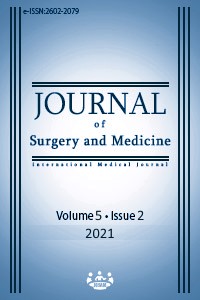Could eosinophil chemotactic factor (CCL11) be a useful biomarker of Covid-19?
Keywords:
Covid-19, ECF, CCL11, Diagnosis, Neutropenia, LymphopeniaAbstract
Background/Aim: Differentiating COVID-19 positive patients from negative ones with similar symptoms and predicting the course of disease are major problems in COVID-19. For this purpose, we investigated the performance of Eosinophil Chemotactic Factor (CCL11) in COVID-19 and compared complete blood count parameters and indexes. Methods: In this retrospective case-control study, ECF/CCL11 values, as well as the clinical, laboratory and radiological data of thirty patients who were diagnosed with Covid-19 between 15 March-15 June 2020 were compared with those of thirty healthy controls. Results: Both patients and controls included 10 (33.30%) females and 20 (66.60%) males with a mean age of 57.2 (15.46) and 60.07 (20.59) years, respectively. Eosinophil counts of the patients on admission (EO1) were significantly lower than those of the controls and one-week later EO2 levels (P<0.001, P=0.004 respectively). EO1, NE1, NE2, PLT2/LYM2, LYM1/CRP1 and LYM2/CRP2 were the most predictive indexes. ECF values of the patients one week after admission (ECF2) were significantly lower than that of controls and admission levels (P=0.046, P=0.011 respectively). ECF2 values differentiated Covid19 negative individuals from patients with 46.70% sensitivity, 93.30% specificity at a cutoff value of ≤45.00 pg/mL. In ROC analysis of ECF2, AUC was 0.702 (P=0.045). Conclusions: Tracking ECF with CBC subsets and indexes may be helpful in the early prediction of severity, diagnosis, and follow up of critical COVID-19 patients in the course of the disease.
Downloads
References
Zhou P, Yang X-L, Wang X-G, Hu B, Zhang L, Zhang W, et al. A pneumonia outbreak associated with a new coronavirus of probable bat origin. Nature. 2020;579(7798):270-3.
Paules CI, Marston HD, Fauci AS. Coronavirus infections—more than just the common cold. Jama. 2020;323(8):707-8.
Erickson MA, Morofuji Y, Owen JB, Banks WA. Rapid transport of CCL11 across the blood-brain barrier: regional variation and importance of blood cells. Journal of Pharmacology and Experimental Therapeutics. 2014;349(3):497-507.
Rothenberg ME, Hogan SP. The eosinophil. Annual review of immunology. 2006;24.
Nakayama T, Hirahara K, Onodera A, Endo Y, Hosokawa H, Shinoda K, et al. Th2 cells in health and disease. Annual review of immunology. 2017;35:53-84.
Lambrecht BN, Hammad H. The immunology of asthma. Nature immunology. 2015;16(1):45-56.
Blanchard C, Rothenberg ME. Biology of the eosinophil. Advances in immunology. 2009;101:81-121.
Kitaura M, Nakajima T, Imai T, Harada S, Combadiere C, Tiffany HL, et al. Molecular cloning of human eotaxin, an eosinophil-selective CC chemokine, and identification of a specific eosinophil eotaxin receptor, CC chemokine receptor 3. Journal of Biological Chemistry. 1996;271(13):7725-30.
Rankin SM, Conroy DM, Williams TJ. Eotaxin and eosinophil recruitment: implications for human disease. Molecular medicine today. 2000;6(1):20-7.
Du Y, Tu L. Clinical Features of 85 Fatal Cases of COVID-19 from Wuhan. A Retrospective Observational Study. 2020;201(11):1372-9. doi: 10.1164/rccm.202003-0543OC. PubMed PMID: 32242738.
Yao X, Zeng Y, Tong Y, Tang X, Yin Z. Determination and analysis of blood eosinophil in 200 severe acute respiratory syndrome patients. Lab Med. 2004;5(19):444-5.
Li Q, Ding X, Xia G, Chen H-G, Chen F, Geng Z, et al. Eosinopenia and elevated C-reactive protein facilitate triage of COVID-19 patients in fever clinic: a retrospective case-control study. E Clinical Medicine. 2020:100375.
Li X, Xu S, Yu M, Wang K, Tao Y, Zhou Y, et al. Risk factors for severity and mortality in adult COVID-19 inpatients in Wuhan. Journal of Allergy and Clinical Immunology. 2020.
Jose P, Griffiths-Johnson D, Collins P, Walsh D, Moqbel R, Totty N, et al. Eotaxin: a potent eosinophil chemoattractant cytokine detected in a guinea pig model of allergic airways inflammation. The Journal of experimental medicine. 1994;179(3):881-7.
Van Coillie E, Van Damme J, Opdenakker G. The MCP/eotaxin subfamily of CC chemokines. Cytokine & growth factor reviews. 1999;10(1):61-86.
Riggioni C, Comberiati P, Giovannini M, Agache I, Akdis M, Alves-Correia M, et al. A compendium answering 150 questions on COVID-19 and SARS-CoV-2. Allergy. 2020:10-111.
Bass DA. Behavior of eosinophil leukocytes in acute inflammation. II. Eosinophil dynamics during acute inflammation. The Journal of clinical investigation. 1975;56(4):870-9.
Hassani M, Leijte G, Bruse N, Kox M, Pickkers P, Vrisekoop N, et al. Differentiation and activation of eosinophils in the human bone marrow during experimental human endotoxemia. Journal of Leukocyte Biology. 2020.
Downloads
- 517 724
Published
Issue
Section
How to Cite
License
Copyright (c) 2021 Muzaffer Katar
This work is licensed under a Creative Commons Attribution-NonCommercial-NoDerivatives 4.0 International License.
















